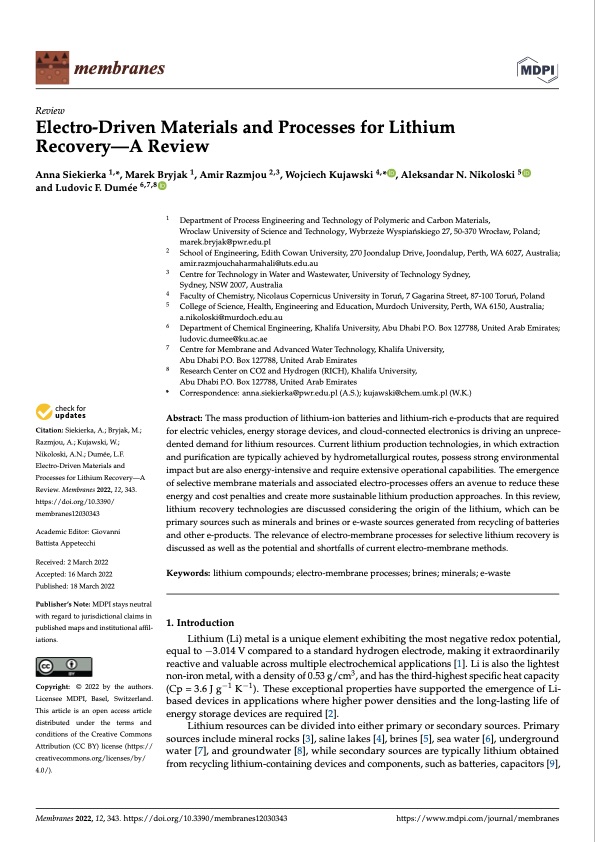
PDF Publication Title:
Text from PDF Page: 001
membranes Review Electro-Driven Materials and Processes for Lithium Recovery—A Review Anna Siekierka 1,*, Marek Bryjak 1, Amir Razmjou 2,3, Wojciech Kujawski 4,* , Aleksandar N. Nikoloski 5 and Ludovic F. Dumée 6,7,8 Citation: Siekierka, A.; Bryjak, M.; Razmjou, A.; Kujawski, W.; Nikoloski, A.N.; Dumée, L.F. Electro-Driven Materials and Processes for Lithium Recovery—A Review. Membranes 2022, 12, 343. https://doi.org/10.3390/ membranes12030343 Academic Editor: Giovanni Battista Appetecchi Received: 2 March 2022 Accepted: 16 March 2022 Published: 18 March 2022 Abstract: The mass production of lithium-ion batteries and lithium-rich e-products that are required for electric vehicles, energy storage devices, and cloud-connected electronics is driving an unprece- dented demand for lithium resources. Current lithium production technologies, in which extraction and purification are typically achieved by hydrometallurgical routes, possess strong environmental impact but are also energy-intensive and require extensive operational capabilities. The emergence of selective membrane materials and associated electro-processes offers an avenue to reduce these energy and cost penalties and create more sustainable lithium production approaches. In this review, lithium recovery technologies are discussed considering the origin of the lithium, which can be primary sources such as minerals and brines or e-waste sources generated from recycling of batteries and other e-products. The relevance of electro-membrane processes for selective lithium recovery is discussed as well as the potential and shortfalls of current electro-membrane methods. Keywords: lithium compounds; electro-membrane processes; brines; minerals; e-waste 1. Introduction Lithium (Li) metal is a unique element exhibiting the most negative redox potential, equal to −3.014 V compared to a standard hydrogen electrode, making it extraordinarily reactive and valuable across multiple electrochemical applications [1]. Li is also the lightest non-iron metal, with a density of 0.53 g/cm3, and has the third-highest specific heat capacity (Cp = 3.6 J g−1 K−1). These exceptional properties have supported the emergence of Li- based devices in applications where higher power densities and the long-lasting life of energy storage devices are required [2]. Lithium resources can be divided into either primary or secondary sources. Primary sources include mineral rocks [3], saline lakes [4], brines [5], sea water [6], underground water [7], and groundwater [8], while secondary sources are typically lithium obtained from recycling lithium-containing devices and components, such as batteries, capacitors [9], Publisher’s Note: MDPI stays neutral with regard to jurisdictional claims in published maps and institutional affil- iations. Copyright: © 2022 by the authors. Licensee MDPI, Basel, Switzerland. This article is an open access article distributed under the terms and conditions of the Creative Commons Attribution (CC BY) license (https:// creativecommons.org/licenses/by/ 4.0/). 1 2 3 4 5 6 7 Department of Process Engineering and Technology of Polymeric and Carbon Materials, WroclawUniversityofScienceandTechnology,Wybrzez ̇eWyspian ́skiego27,50-370Wrocław,Poland; marek.bryjak@pwr.edu.pl School of Engineering, Edith Cowan University, 270 Joondalup Drive, Joondalup, Perth, WA 6027, Australia; amir.razmjouchaharmahali@uts.edu.au Centre for Technology in Water and Wastewater, University of Technology Sydney, Sydney, NSW 2007, Australia FacultyofChemistry,NicolausCopernicusUniversityinTorun ́,7GagarinaStreet,87-100Torun ́,Poland College of Science, Health, Engineering and Education, Murdoch University, Perth, WA 6150, Australia; a.nikoloski@murdoch.edu.au Department of Chemical Engineering, Khalifa University, Abu Dhabi P.O. Box 127788, United Arab Emirates; ludovic.dumee@ku.ac.ae Centre for Membrane and Advanced Water Technology, Khalifa University, Abu Dhabi P.O. Box 127788, United Arab Emirates 8 Abu Dhabi P.O. Box 127788, United Arab Emirates Research Center on CO2 and Hydrogen (RICH), Khalifa University, * Correspondence: anna.siekierka@pwr.edu.pl (A.S.); kujawski@chem.umk.pl (W.K.) Membranes 2022, 12, 343. https://doi.org/10.3390/membranes12030343 https://www.mdpi.com/journal/membranesPDF Image | Electro-Driven Materials and Processes for Lithium

PDF Search Title:
Electro-Driven Materials and Processes for LithiumOriginal File Name Searched:
membranes-12-00343-v3.pdfDIY PDF Search: Google It | Yahoo | Bing
Product and Development Focus for Infinity Turbine
ORC Waste Heat Turbine and ORC System Build Plans: All turbine plans are $10,000 each. This allows you to build a system and then consider licensing for production after you have completed and tested a unit.Redox Flow Battery Technology: With the advent of the new USA tax credits for producing and selling batteries ($35/kW) we are focussing on a simple flow battery using shipping containers as the modular electrolyte storage units with tax credits up to $140,000 per system. Our main focus is on the salt battery. This battery can be used for both thermal and electrical storage applications. We call it the Cogeneration Battery or Cogen Battery. One project is converting salt (brine) based water conditioners to simultaneously produce power. In addition, there are many opportunities to extract Lithium from brine (salt lakes, groundwater, and producer water).Salt water or brine are huge sources for lithium. Most of the worlds lithium is acquired from a brine source. It's even in seawater in a low concentration. Brine is also a byproduct of huge powerplants, which can now use that as an electrolyte and a huge flow battery (which allows storage at the source).We welcome any business and equipment inquiries, as well as licensing our turbines for manufacturing.| CONTACT TEL: 608-238-6001 Email: greg@infinityturbine.com | RSS | AMP |